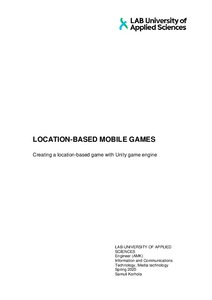Exploring the use of procedural content generation demonstrated in a simple 2D video game
Widdowson, Elina (2024)
Widdowson, Elina
2024
All rights reserved. This publication is copyrighted. You may download, display and print it for Your own personal use. Commercial use is prohibited.
Julkaisun pysyvä osoite on
https://urn.fi/URN:NBN:fi:amk-2024120533175
https://urn.fi/URN:NBN:fi:amk-2024120533175
Tiivistelmä
The primary objective of this thesis was to explore the use of procedural content generation (PCG) for indie games demonstrated in a simple two-dimensional (2D) minimum viable product (MVP) video game called Adventure Game. This thesis focused on procedural level generation. The level generation uses binary space partitioning as a tool to create game levels called “dungeons”, which are comprised of randomly generated rooms and corridors.
The MVP game was written in C# and uses the Godot game engine as well as Godot libraries to build and run the game. The player controls a player character that is able to move through the levels in the game via keyboard commands. Game levels consist of a grid with a coordinate system and tiles, which have different properties. The tiles also have texture sprites, which give the levels their physical appearance. Different textures are placed in different parts of the dungeon to create the appearance of floors, walls and corridors. The dungeons have tiles in three different colour schemes for variety. The MVP game also includes a menu with buttons for starting a new game, continuing a game and quitting the game. The procedurally generated levels contain randomly placed items and entrances that load a new level when the player character walks over them.
The procedural content generation in the game was evaluated based on the properties of reliability, controllability, speed, expressivity and diversity, and creativity and believability. A checklist of functions and criteria that the procedural level generation system had to meet was also devised prior to development, and the MVP game was evaluated against this checklist. The MVP game fulfilled the criteria set out in the checklist and the procedural level generation system was deemed reliable at generating levels in accordance with the criteria set out for this project. However, whilst the level generation system produced playable levels that were generated with appropriate textures, rooms, and corridors, the resulting levels were not as visually appealing, interesting or creative as something produced by a human level designer. Therefore, the PCG system developed for this thesis was successful in producing randomly generated levels. However, these levels lacked the creativity and diversity of levels designed by humans.
The MVP game was written in C# and uses the Godot game engine as well as Godot libraries to build and run the game. The player controls a player character that is able to move through the levels in the game via keyboard commands. Game levels consist of a grid with a coordinate system and tiles, which have different properties. The tiles also have texture sprites, which give the levels their physical appearance. Different textures are placed in different parts of the dungeon to create the appearance of floors, walls and corridors. The dungeons have tiles in three different colour schemes for variety. The MVP game also includes a menu with buttons for starting a new game, continuing a game and quitting the game. The procedurally generated levels contain randomly placed items and entrances that load a new level when the player character walks over them.
The procedural content generation in the game was evaluated based on the properties of reliability, controllability, speed, expressivity and diversity, and creativity and believability. A checklist of functions and criteria that the procedural level generation system had to meet was also devised prior to development, and the MVP game was evaluated against this checklist. The MVP game fulfilled the criteria set out in the checklist and the procedural level generation system was deemed reliable at generating levels in accordance with the criteria set out for this project. However, whilst the level generation system produced playable levels that were generated with appropriate textures, rooms, and corridors, the resulting levels were not as visually appealing, interesting or creative as something produced by a human level designer. Therefore, the PCG system developed for this thesis was successful in producing randomly generated levels. However, these levels lacked the creativity and diversity of levels designed by humans.
Kokoelmat
Samankaltainen aineisto
Näytetään aineisto, joilla on samankaltaisia nimekkeitä, tekijöitä tai asiasanoja.
-
Game Development in Unity : Game Production, Game Mechanics and the Effects of Gaming
Dansie, Jason (Metropolia Ammattikorkeakoulu, 2013)The goal of this thesis is to examine how video games are designed and to see how differ-ent game mechanics work and how to use them in the development of a game, as well as examine what are both the positive and negative ... -
Location-based mobile games : creating a location-based game with the Unity game engine
Korhola, Samuli (2020)The subject of this thesis is location-based mobile games. Location-based mobile games are a way for mobile games to combine reality with virtual worlds and thus re-define the gaming experience. This thesis presents ... -
”WE WANT A 3D GAME” : Customer expectations for the games company when buying a serious game
Sorppanen, Mikko (Oulun seudun ammattikorkeakoulu, 2012)All digital games are not used for entertainment. Some of them can also be used for non-entertainment purposes and these games are called serious games. This thesis is carried out in co-operation with one Finnish games ...



